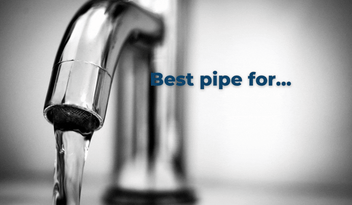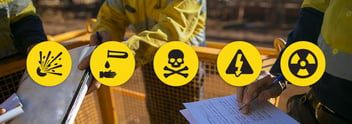PE vs PVC pipe, which should I choose?
As technology and manufacturing processes change, as well as customer attitudes, it is essential to stay informed of core industry knowledge. Seasoned professionals understand the core differences between PE and PVC pipe, but there’s always more to learn.
At Waterworks, we often get asked about the distinctions between PE and PVC, and what applications each one is suited to. In this article, we discuss this question and highlight a few important aspects to consider.
Characteristics of PE piping
Made from the polymerisation of ethylene, Polyethylene (PE) is a thermoplastic material used for a range of applications.
PE piping can be extruded in a range of sizes, from 13mm to 2000mm in diameter. PE pipe is available in both straight lengths and coils. Typically, smaller sizes are available in both coils and straight lengths, while large sizes are available in 6m, 12m, 18m, or 21m straight lengths although some customisation is available for large production runs.
Lightweight
When it comes to installation and maintenance, the lightweight nature of PE is a significant advantage. With heavier alternatives, such as steel or concrete, installation is a more time-consuming and labour-intensive process, while PE is quick and efficient.
PE can be installed with methods including open trench or using trenchless technology such as horizontal directional drilling, pipe bursting, or slip-lining. These help to streamline the process and save considerable time and money on the job site. PE pipe is suitable for both below and above-ground installations. It is typically joined using a mechanical fitting, such as a compression fitting, or by using a fusion welding technique such as electro-fusion or butt fusion.
Chemical resistant
Due to its non-polar nature, Polyethylene has exceptional resistance to some chemicals meaning it is not affected by aqueous solutions of salts, acids, and alkalis, and can even tolerate many solvents. Unlike some piping materials, PE will not rust, rot, pit, corrode, tuberculate, or support biological growth, making it ideal for harsh chemical environments.
Flexible
PE pipe is relatively flexible, making it a great choice for many complex systems. It can be field bent to a radius of 30 times the nominal pipe diameter which can reduce the need for fittings. Flexibility is a key benefit for many applications with fewer fittings needed, easier installation, lower frictional loss, and protection from joint fatigue.
Strong and durable
Provided the system is properly designed, installed, and operated, PE pipe has a life expectancy of over 100 years. Durability is key because the less maintenance, replacements, and servicing required, the more cost-effective the system is.
The strength of PE, it being less brittle, along with its flexibility typically mean ground or trench preparation is less critical than PVC alternatives as PE is more tolerant of foreign debris which may be found in the ground, a time-saving for installers.
Leak-free joints
To fuse PE pipes together, heat is applied to form a completely leak-free joint. These joints are as strong or even stronger than the pipe itself, making them extremely reliable connections. Heat fusions are far more robust compared to the bell and spigot-type fittings used for other materials, which have a higher probability of a potential leak point.
Hydraulically efficient
Internally, PE pipe is incredibly smooth, meaning it has low resistance to fluid flow. The even surface of the PE pipe does not enable sediment build-up or internal erosion, meaning there is no opportunity for friction to increase over time. For example, PE pipelines that transport water will have a Hazen Williams C factor of 150, far better than steel or cast iron.
Resistant to extreme temperatures
Depending on the location and climate of your piping system, you will need to think about the temperatures it will operate in. Fortunately, PE pipes perform well in a variety of temperatures.
For pressure services, the typical operating temperature range is from –18ºC to 60ºC. For non-pressure and special applications, it can handle much lower temperatures, even as lower as –40°C. This way, you can be confident that your piping network will work as it should all year round.
Resistance to slow crack growth and rapid crack propagation
Whilst we won’t go into detail in this blog on these two terms commonly used in the plastic piping industry, PE has demonstrated a resistance to both slow crack growth and rapid crack propagation over a wide temperature range.
Characteristics of PVC piping
Made from the polymerisation of the vinyl chloride monomer, Polyvinyl chloride (PVC) is another widely used plastic piping material. Across building and construction, healthcare, electronics, automobile and many other industries, PVC is renowned for its durability, recyclability, safety, and longevity.
For information on the various sizes of PVC pipes, see our explanation here.
But what are the characteristics of PVC piping, and what sets it apart from other materials?
Thermal expansion
PVC is less sensitive to thermal expansion and contraction than PE, meaning in applications where there is large temperature fluctuation there will be less movement in the pipework.
Durability
Over 80 years ago, the first PVC piping lines were installed and today, most are still in use. The expected lifespan of PVC piping is more than 100 years, with a much lower failure rate than alternatives like cast iron, ductile iron, concrete, steel, and asbestos cement pipes.
While these materials are prone to a range of problems, from pinhole leaks to major ruptures, PVC pipe failures can largely be avoided with correct maintenance and installation.
One point you do need to be aware of, however, PVC is not ideally suited for low temperatures. Low temperatures, usually below 4°C, can cause PVC to become brittle and deteriorate which is one cause of failure in PVC pipework.
Another factor which can cause deterioration in PVC pipework is exposure to UV. Whilst manufacturers can include UV inhibitors in the production process, PVC will deteriorate over time from UV exposure. There is no proven timeframe in which this deterioration occurs. It is a factor installers need to be aware of and take steps to minimise the impacts, particularly for above-ground pipework.
Cost-efficient
Compared to alternatives, PVC pipes are incredibly cost-effective over the entire lifetime of the system. With less maintenance downtime, fewer replacements, faster installation, and affordable purchase prices, PVC pipes are a viable option for most applications.
Being a rigid material, PVC pipework is restricted to straight lengths which can mean you have higher transport costs per metre of pipe compared to PE pipe which can be coiled.
Less bracketing
Having a higher rigidity than PE pipe, typically means PVC pipework requires fewer pipe supports. This presents a key benefit for installers and can result in project savings as it means less bracketing costs.
Chemical resistance
Like PE, the main chain of polymer is made by single bonds of carbon atoms, meaning PVC also has excellent chemical resistance. This combined with its good mechanical properties is why PVC is commonly used in chemical applications such as water and wastewater treatment, centralised cleaning, and swimming pool applications.
Sustainable and recyclable – environmental performance
PVC pipes are one of the most sustainable piping materials because it is a low-carbon plastic which requires less energy to manufacture, and is recyclable 8 to 10 times over.
Additionally, lightweight pipes need less energy to be transported helping to keep emissions down. The smooth surface of PVC pipes also helps to reduce energy use during operation – good for both the environment and the budget.
Choosing between PE and PVC piping
Both PVC and PE pipes are durable, cost-effective, and lightweight making it difficult to choose between them. However, with a few core differences, these two solutions are best suited for different applications.
Four key questions you can ask for deciding which material you should select are:
- What is the liquid or substance going through the pipework?
- What are the maximum and minimum operating temperatures of the liquid or substance going through the pipework?
- What are the maximum and minimum operating pressures of the system?
- What are the maximum and minimum ambient temperatures of the system?
The unique advantages of PVC piping make it ideal for applications with lower temperature variation, which are protected from UV exposure, or where the pipework is suspended. If this aligns with your project, talk to our team about PVC fittings and glue.
On the other hand, PE piping is unrivalled when it comes to applications requiring fewer joins, greater flexibility, using trenchless technology, and resistance to extreme temperatures. If this aligns with your project, talk to our team about our PE piping solutions.
Knowing the differences between PVC and PE piping, you can now decide which is the best option for your system. Both piping solutions are dependable, high-quality innovations that have transformed the way piping infrastructure can function.
For more information on recommendations and specifications, speak with our expert team. We can help to connect you with the most suitable products to get your systems up and running, as well as guarantee the quality that you deserve.
To find out more about your options, browse our range of piping products.

.png)


-1.png?width=352&name=Copy%20of%20WW%20%20Blog%20headers%202023%20(19)-1.png)
